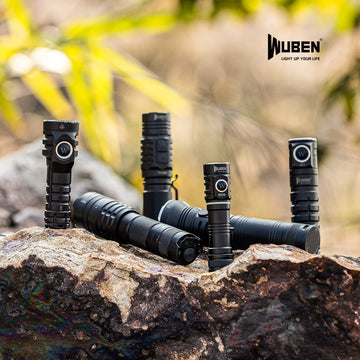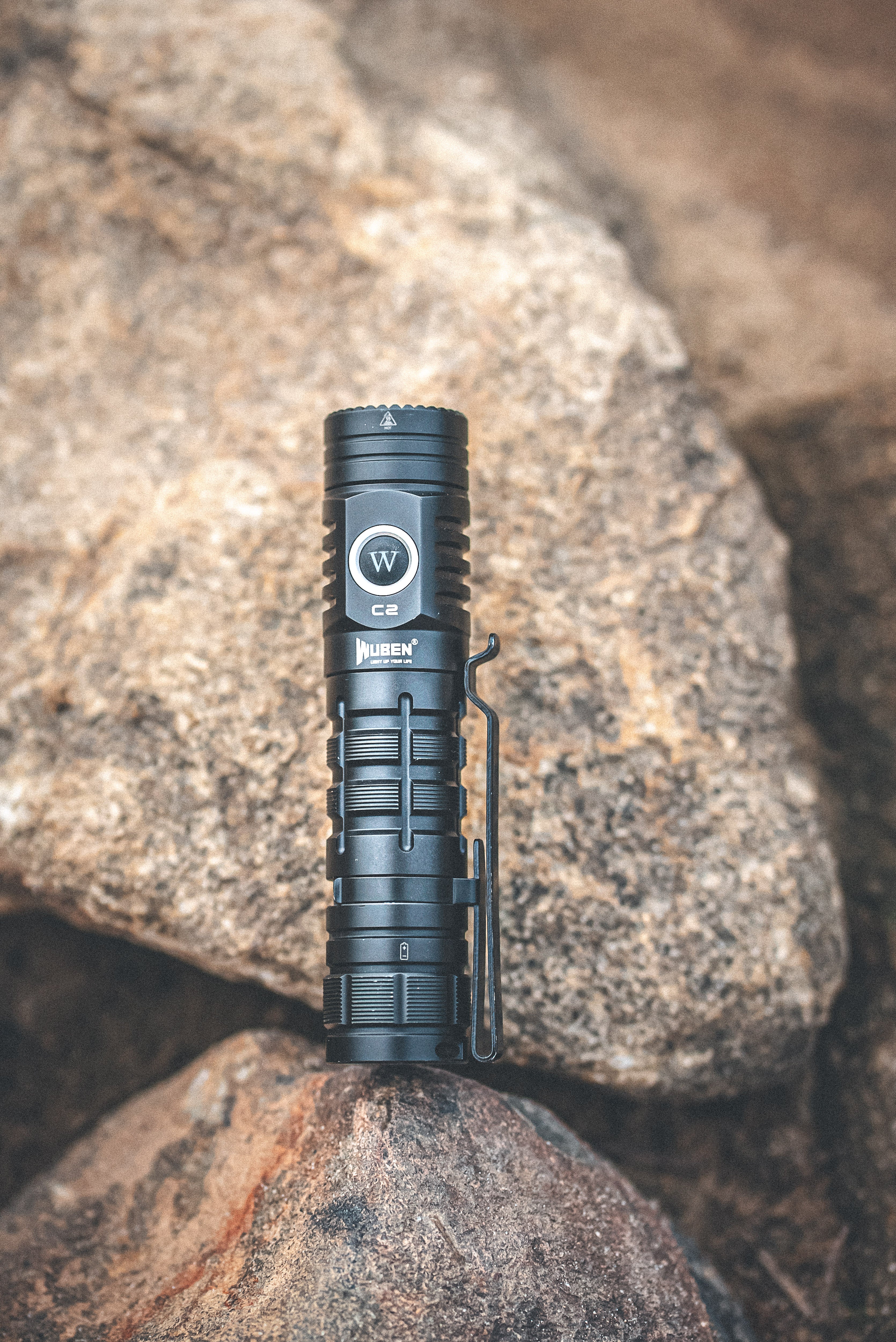
4 Ways To Use Wuben Flashlights Correctly

Enjoy a 15% discount on all Wuben X series products, including X0, X1, X2, and X3.
Using a flashlight seems pretty straightforward right? This maybe the case with older models with filament bulbs and a single power output and just a simple on-off function, but now with newer technology, handheld flashlights are more powerful than ever, to an extent where safety precautions need to be considered! They are also packed with other features such flash modes, battery indicators and lockout modes which may take time to learn and get used to!
1.Correct operation
Firstly we will looks at keys do's and don'ts for flashlight operation and maintenance!
✔Do keep it pointed in a safe direction!
✘Don't shine it directly in the eyes as this may cause temporary blindness or permanent eye damage. This is especially important for the more powerful, high output flashlights such as LEP, or high output thrower or flood LED flashlights.
✘Don't cover the flashlight head as this may lead to a fire.
✘Don't stand the flashlight on its head when the power is on as this may cause damage to itself or nearby objects and may also lead to a fire.
✔Do use 'lockout' mode when you carry it in your pocket to prevent it from accidentally turning it on and for preventing battery leaks. Many Wuben flashlights lockout when the switch is pressed 4 times. The light will then blink 3 times to confirm it is in lockout mode. 4 more clicks will take it out of lockout mode. During lockout mode, if the button is pressed, the 'W' button blinks to confirm the flashlight is locked out, but still has a charged battery!
✔Do install the battery with the correct polarity without reversing it.
✔Do keep the flashlight in a dry place and away from young children.
✔Do use breathing lights when camping. This helps you to locate the flashlight in the dark. Many Wuben flashlights have their breathing lights turned on and off by triple clicking.
✔Do check battery compatibility - for example many flashlights use 14500 lithium ion batteries - these are almost identical in size to an AA cell, so some flashlights like the Wuben C5 and E6 are compatible with both. However other flashlights, such as UV torches are only compatible with AA batteries and using 14500 batteries in these can damage the circuitry. Other flashlights, such as the Wuben C2 and B2 are compatible with both 18650 and 21700 lithium ion batteries!
Having a reliable bike light can assure your safety. B2 1300 Lumens Bike Light delivers a maximum of 1300 lumens, it’s more than enough for both urban commuting and riding on unlit roads. you can instantly illuminate your surroundings. Only sale $39.99 && Shop Now!
✔Do check the IP (ingress protection) rating of the flashlight, to ensure it is suitable for the environment it is used in. For example, if a flashlight is IP68 rated, it can be submerged in 2m of water for 1 hour. Common IP ratings for flashlights are below:
|
IP rating |
Meaning |
|
IP65 |
Protected from low pressure water jets in any direction |
|
IP68 |
Protected from long term immersion up to a specified pressure e.g. 2m under water from 1 hour |
|
IPX7 |
Fully submersible in 1m of water for 30 minutes |
|
IPX8 |
Can withstand continuous submersion in water |
✔Do familiarise with the flashlight's battery indicators. Most quality flashlights have these to tell you when it is time to charge and the percentage of battery power left. The table below shows the meaning of the battery indicator (normally on the 'W' button) on Wuben flashlights to tell you how much charge (C) is left:
|
Button indication |
Battery charge (C) |
|
Constant blue light for 5 seconds |
C ≥ 90% |
|
Blue light flashes for 5 seconds |
90% > C ≥ 40% |
|
Red light constant on for 5 seconds |
40% > C ≥ 15% |
|
Red light flashes |
15% > C > 0% |
2.Practise turning the flashlight on and off and using the different modes
Flashlights can either have a push button or be operated with a twist cap. Buttons can be faster and easier to turn on, cycle through the modes and be operated with one hand. Button flashlights also have two types of on settings to get used to- momentary-on and constant-on. Momentary-on means only having to slightly press the button to turn it on and it will turn off as soon as the button is released. Constant-on means clicking the button so it stays on.
Twist cap flashlights need to be operated with both hands but are less likely to be put on by accident whilst in the pocket. They also tend to be more compact. Many keychain flashlights tend to be twist cap operated as they are usually in the pocket attached to keys, so are likely to be accidently turned on than if they have button operation. Both button and twist cap flashlights have their own advantages, but need to be practised with.
Flashlights also have different modes to be familiarized with - most Wuben flashlights like the C2 have 'turbo' (its highest setting for a short amount of time e.g. 1 minute, to prevent it overheating) along with 'high', 'medium' and 'low' settings. They require cycling through the modes, but have a memory function, so if you turn off the flashlight and put it back on again, it will return to the previous output setting.
Don't have a flashlight when worried about camping?But if you have the C2 FlashLight, you can instantly illuminate your surroundings. Only sale $46.99 && Shop Now !
Flash modes are also a common feature and there are two types to familiarize with and be aware of -'strobe' for self defence and 'SOS' for being rescued. Strobe is a mode to disorientate and cause an assailant to feel nauseous. As well as temporarily blinding, strobe also makes the person feel uncomfortable due to the principle of 'flicker vertigo' (also known as the 'Bucha effect') which is when light with a frequency of 1-20 Hz, which is the same as that of brainwaves, causes feelings of sickness. When the assailant feels this way due to strobe, it gives time to the flashlight user to subdue or escape from the assailant. It is important to know what will make the flashlight strobe in order to prevent accidental temporary blindness!
3.Using a tactical flashlight for self-defence
You may choose to have a tactical flashlight as they are durable, have a high output and have a strike bezel. As well as being used in tactical situations, they are also great as everyday carry torches! Below are tips on how to use the flashlight for tactical purposes:
- TheFBI technique is a well known method to use a tactical flashlight to help you hide your location and trick potential attackers. To do this, hold the tactical flashlight away from your body and direct the beam in a different direction.
-
The flash and scantechnique requires a flashlight that’s either momentarily-on or has a fast on-off switch. It does not work if you have to scroll through lighting modes to turn off your flashlight. To do the flash and scan technique:
- Stand still
- Shine the flashlight
- Quickly observe the area and look for threats and obstacles to form a mental map
- Turn the flashlight off
- Move, using that mental map
- Repeat
- If you see a threat, move in a fast and unpredictableway
- An assailant is likely to attack your last known position, which is where your light was shining from
- If an assailant is trying to attack you, shine the beam directly into his eyes. This will temporarily blind him. At this point you can either escape or crack him in the face with the strike bezelor kick him in the groin! The chin is an effective strike area and if you are taller than the assailant, it is easier for you to strike the temple.
- If you are armed with a gun, the tactical flashlight will help you to aim.
4.Battery preservation
Modern flashlights are normally conveniently charged with a USB cable. To make the charge long lasting, li-ion (lithium ion) batteries are a powerful and durable choice. There are some things you can do that can help further prolong their lifespan!
- Ensure they do not get too hot or cold: Storing them in a vehicle on a hot day may slightly reduce their lifespan. Room temperature is optimal and storage in a cupboard, drawer, box or wardrobe where the temperature does not rapidly increase or decrease will work well.
- Ensure they do not get wet: This can happen with condensation in damp areas or direct contact with water.
- Avoid pressured environments: A flight on an aeroplane will create a pressured environment which may potentially cause damage to a li-ion battery. The CAA allows two protected spare batteries per personand the terminals must be insulated with for example, tape. Each battery must be placed in a separate bag or pouch. The batteries must only be taken on carry-on baggage and not checked-in baggage!
- Never completely discharge batteries - put them on charge when you know they are low.
- Fully charge your batteries fully before their first use.
- Never charge batteries to above their specified voltage.
- Avoid charging them unattended.
- Avoid storing li-ion batteries fully charged for extended periods of time.
- Use high-quality battery chargers designed specifically for use with li-ion batteries.
- Always charge your batteries on fireproof material, such as a heatproof mat.
- Don’t use or charge any battery or use a charger with any visible damage.
- When storing and transporting your batteries, use a purpose-built case to keep them safe.
- Avoiding keeping a spare li-ion battery loose in your pocket, bag or purse, because it can become damaged.
- Do not use a battery if it overheats, hisses, or bulges - immediately take the battery away from any flammable materials and take it outside as soon as possible.
- Avoid leaving a damaged battery unattended, until you can safely dispose of it.
Summary
Tips for battery care and tactical usage have been discussed. As modern flashlights can cause harm when directly shined in your eyes, point it in safe directions. Practise getting used to different modes (especially to avoid strobing yourself!) and know what the battery indicator means - you can always read the instructions or watch videos to help you with these!






